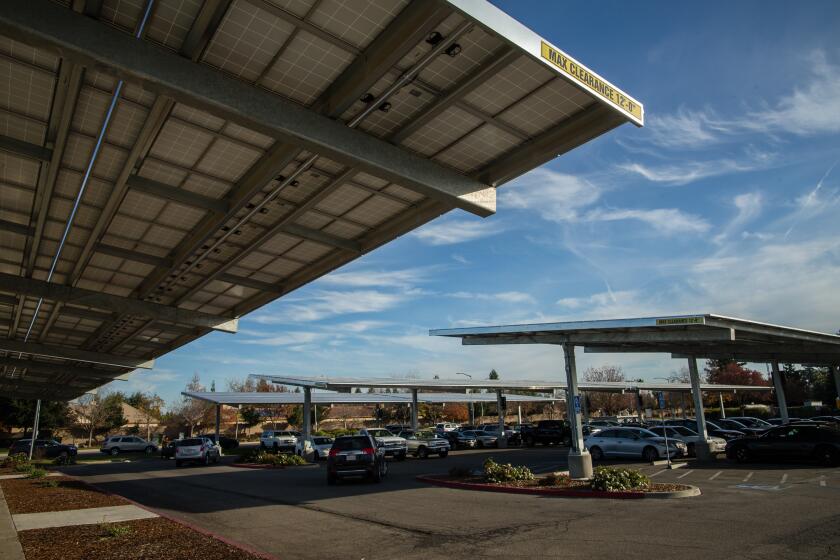Editorial: Port pollution is surging. Let regulators do their job to protect public health

One reason Southern California’s air has been so dirty recently is a big increase in diesel emissions from the ports of Los Angeles and Long Beach.
Supply chain problems, a backup of container ships and record cargo volumes have caused a surge in lung-damaging pollution, worsening smog from the harbor area to the Inland Empire. Fine-particle pollution in downtown L.A. in November jumped to levels more than 40% higher than in previous years.
The pandemic-fueled boom in shipping activity has only exacerbated long-standing health risks from the massive hub for diesel trucks, container ships and cargo-moving equipment. The port complex is Southern California’s largest source of smog-forming pollution, responsible for more than 10% of its nitrogen oxide emissions. Though port emissions improved dramatically under a 2006 clean-air plan that banned the dirtiest diesel trucks, progress has tapered off in recent years. L.A. Mayor Eric Garcetti and Long Beach Mayor Robert Garcia pledged in 2017 to transform the ports into largely zero-emission operations by 2035, but the few actions they’ve taken to date fall far short.
Southern California air quality has been getting worse in recent years, and the region will miss a key 2023 smog reduction deadline, putting it at risk of federal Clean Air Act sanctions, which could mean losing billions in federal funding. Too many communities, from Wilmington to San Bernardino, are forced to live with the consequences of that failure: unhealthy and life-shortening smog and soot that is bad for everyone but worst for the most vulnerable, including children whose lungs are still developing.
Newsom’s one-time budget-surplus funding plan for climate change is a good thing. But it’s no substitute for real climate action by state lawmakers.
Yet city officials who operate the nation’s busiest port complex are showing no urgency to protect people’s lungs from the pollution. We can’t keep waiting. Air quality regulators should forge ahead with rules to force the ports to act.
After years of closed-door negotiations between the ports and smog regulators in pursuit of a voluntary agreement to reduce pollution, the South Coast Air Quality Management District’s governing board voted last August to give the ports six more months to reach a deal or it will begin drafting mandatory pollution rules.
That deadline is Feb. 4, but no agreement has been reached yet. The ports’ offers to date have been so weak they would cut far less pollution than what they projected five years ago when the two cities updated their Clean Air Action Plan, according to the air district. What’s more, port officials want an agreement that lacks enforceable commitments and includes provisions that would allow them to walk away without meeting their obligations.
For the sake of the health of millions of people who breathe some of the nation’s smoggiest air, the AQMD board must adhere to the plan it approved last year and allow agency staff to move ahead with rules to rein in port pollution, without any backsliding.
Whether the agency will stick to its plan and start developing these rules is an open question because of the divided politics of its board, which is made up of 13 local politicians and other appointees across Los Angeles, Orange, Riverside and San Bernardino counties, some of them steadfastly opposed to regulating ports and other magnets for freight pollution. Key members of the AQMD board have dual loyalties, serving as both air quality regulators and representatives of the two cities that operate the ports and have long fought regulation.
California won’t be able to meet its targets at its current pace of pollution reduction. Here are three actions state officials can take in the next year to pick up the pace.
Los Angeles City Councilman Joe Buscaino, who for years has been Mayor Eric Garcetti’s appointee to the AQMD board and is running for mayor himself, has opposed the air district regulating the ports, even though his harbor-area constituents are among those hardest hit by elevated cancer risk, asthma rates and other health problems associated with their operations. His term on the air board expired earlier this month, and he needs to be replaced with someone who will support rules to cut port pollution and reduce the health damage. Garcetti’s office said Wednesday the mayor would soon announce a new appointee to take Buscaino’s place.
Long Beach City Councilman Rex Richardson, who is also running for mayor of his city, supports a voluntary agreement backed up with rules or financial penalties to hold the ports to their commitments, and is among the air board members who want to keep negotiating with port officials even as district staff begin work on regulations.
That’s trying to have it both ways and could ultimately mean further delay and weakening of a rule-making process that must proceed with focus, urgency and transparency. That’s unacceptable.
Southern California still suffers the nation’s worst-polluted air but it also has a decades-long record of success in fighting smog, which has been achieved largely through stringent regulation, not by cutting deals with polluters. AQMD leaders have shown with recently adopted rules on oil refineries and warehouse logistics centers that they have the authority and political will to take meaningful action against some of the region’s most powerful industries. They can and should do the same with the ports.
More to Read
A cure for the common opinion
Get thought-provoking perspectives with our weekly newsletter.
You may occasionally receive promotional content from the Los Angeles Times.








